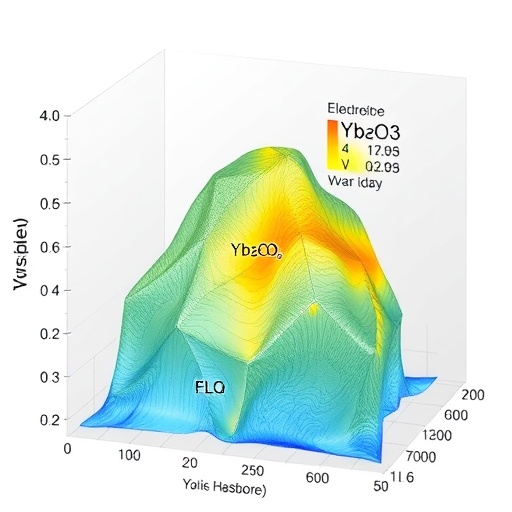The quest for new materials that can endure harsh operating conditions while maintaining functional properties at intermediate temperatures has led researchers to explore various compounds within the realm of solid electrolytes. A new study by Li et al. delves into the implications of Yb2O3 content on the performance metrics of YbScSZ electrolyte, which is gaining traction among scientists for its potential use in energy storage and conversion technologies.
Ytterbium oxide (Yb2O3) is emerging as a notable additive in the development of solid electrolytes due to its unique electronic properties. This element, when combined with other stable compounds, can significantly influence the microstructural characteristics and ionic conductivity of an electrolyte. The research team aimed to understand how varying Yb2O3 concentrations can alter these attributes in YbScSZ, which is a zirconia-based solid electrolyte. The pioneering aspect of their study lies in its systematic investigation into the phase stability and overall conductivity at mid-range temperatures, which is crucial for real-world applications.
The scientific community recognizes that the stability of the electrolyte phase is vital for effective energy conversion. Traditional approaches often involve high-temperature operations that compromise the stability of ionic conductors. This has prompted investigations into alternative materials that can function efficiently at lower temperatures without sacrificing performance. By examining the phase behavior of YbScSZ at different Yb2O3 contents, the research offers insights into optimizing electrolyte performance for devices such as fuel cells and batteries.
Throughout the investigation, the authors employed state-of-the-art characterization techniques, including X-ray diffraction and scanning electron microscopy, to closely monitor the changes in microstructure and phase composition as Yb2O3 was varied. These methods are not just empirical; they provide critical data that informs the structural integrity of the materials being tested. Sedimentary behavior and the formation of secondary phases at elevated temperatures were observed, leading to in-depth discussions on the possible mechanisms underlying these changes.
The analysis revealed that specific concentrations of Yb2O3 were pivotal in enhancing conductivity while mitigating the formation of undesired phases. A correlation was established between the amount of Yb2O3 present and the overall ionic conductivity of YbScSZ, which suggests that finding the optimal balance can lead to significant advancements in solid electrolyte technology. This is especially important for applications where high ionic conductivity is paramount for efficiency.
Further scrutiny of the microstructural elements highlighted the importance of grain size and porosity on ionic transport properties. Smaller grains often provide shorter pathways for ion movement, thereby enhancing conductivity. Conversely, excessive porosity can act as a barrier to ion migration. The study meticulously discusses how Yb2O3 incorporation modifies these microstructural factors, leading to a comprehensive understanding of how structural changes correlate with functional performance.
Contemporary research underscores the significance of thoroughly understanding phase transformations under operational conditions. The findings from Li et al. contribute greatly to this ever-evolving field of solid-state ionics by providing valuable empirical data and theoretical analysis that links Yb2O3 content with phase stability. Such knowledge can radically influence the material design process for future energy conversion and storage devices tailored for optimized performance.
The effect of environmental conditions on ionic conductivity was also examined. Factors such as temperature and humidity not only affect individual phase components but can also interact to influence overall material behavior. Addressing these variables, the authors suggest that the adaptability of YbScSZ with varying Yb2O3 content may pave the way for more robust electrolytic materials suitable for diverse operating environments. With more countries shifting towards sustainable energy solutions, this research is timely and relevant.
Moreover, the implications of these findings extend beyond just one type of electrolyte. Understanding the interactions of rare earth oxides could spur advancements across various electrolyte formulations, thus catalyzing improvements in numerous applications related to energy technology. The versatility and performance enhancement provided by Yb2O3 could challenge the conventional materials used in solid-state applications, leading to innovations that support modern energy demands.
In conclusion, the research conducted by Li et al. offers a new lens through which to view the development of solid electrolytes, emphasizing the vital role of Yb2O3 content. As the emphasis on renewable energy sources grows, such studies become essential in producing materials capable of high-performance standards. By unlocking the potential of YbScSZ and exploring the nuances of Yb2O3’s impact, the scientific community is one step closer to developing next-generation solid electrolytes tailored for high efficiency and stability at intermediate temperatures.
This study not only sheds light on the specifics of ionic conductors but also demonstrates a broader principle within materials science: that sometimes, minor changes in composition can lead to monumental shifts in performance. As continued investigations build upon this work, it is likely that the landscape of solid electrolytes will witness inspiring transformations in both theory and application.
The implications of this research may not only advance academic circles but also hold commercial promise. As industries aim toward cleaner and more sustainable energy solutions, finding new and improved materials becomes a priority, making the insights derived from Li et al.’s work invaluable for future innovation pathways.
In such a rapidly evolving domain as energy technology, the study encapsulates a glimpse into a promising future where enhanced materials could lead to smarter energy systems—ones that leverage the unique properties of materials like YbScSZ. In the grand tapestry of material science, this narrative weaves in the threads of innovation, discovery, and sustainability.
Subject of Research: Yb2O3 content and its effects on YbScSZ electrolyte properties.
Article Title: The effect of Yb2O3 content on the phase stability, microstructure, and conductivity of YbScSZ electrolyte at intermediate temperatures.
Article References:
Li, W., Ma, J., Tang, F. et al. The effect of Yb2O3 content on the phase stability, microstructure, and conductivity of YbScSZ electrolyte at intermediate temperatures.
Ionics (2025). https://doi.org/10.1007/s11581-025-06691-6
Image Credits: AI Generated
DOI: https://doi.org/10.1007/s11581-025-06691-6
Keywords: Solid Electrolytes, Yb2O3, YbScSZ, Phase Stability, Ionic Conductivity, Microstructure, Energy Technology.




